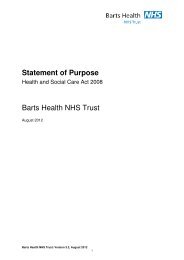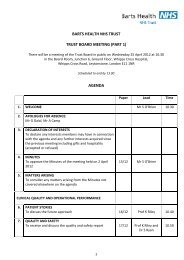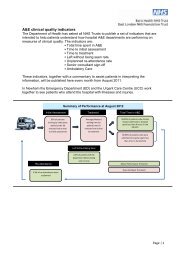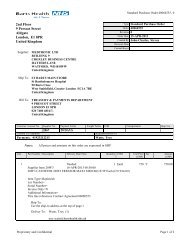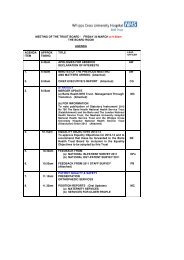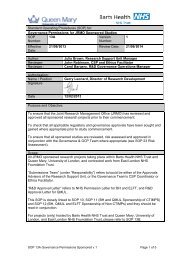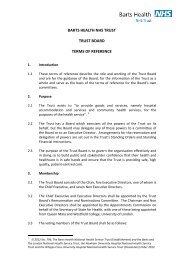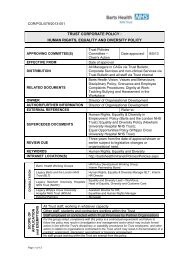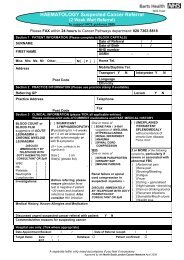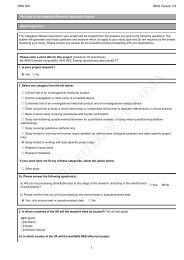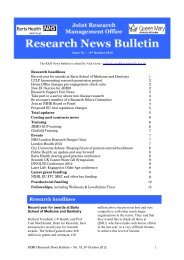Barts Health Equality and Human Rights Impact Assessment Report
Barts Health Equality and Human Rights Impact Assessment Report
Barts Health Equality and Human Rights Impact Assessment Report
- No tags were found...
You also want an ePaper? Increase the reach of your titles
YUMPU automatically turns print PDFs into web optimized ePapers that Google loves.
www.brap.org.uk4. Conclusions <strong>and</strong> recommendationsHopefully, it will be apparent from the above equality analysis <strong>and</strong> baseline review that thereare a wide range of equality <strong>and</strong> human rights issues relating to the proposed merger. In thisfinal concluding section, we suggest a number of ‘high-level’ strategic themes <strong>and</strong> potentialpriorities for the merged Trust as it develops its own approach to progressing equality <strong>and</strong>human rights.Historically, equality approaches have generated large, unwieldy action plans, the results ofwhich are commonly known: people spending more time going through the documentationthan they do taking action! The new equality duty requires organisations to produce a smallnumber of SMART targets. Devising these will be extremely useful in helping the Trust thinkthrough priority areas which can really support its core business objectives going forward.Our view would be for the Trust to prioritise some of the following actions to help themdevelop equality <strong>and</strong> human rights strategy that is right for the new organisation:4.1 Act on what you knowThere is a significant amount of available information that could inform the merged Trust’sfuture strategy on equality <strong>and</strong> human rights in a number of different places. This report isonly part of that equation. We would point to the ‘<strong>Equality</strong> <strong>Impact</strong> <strong>Assessment</strong>: CompletedInitial Screening Form of the Outline Business Case’ (August 2011) <strong>and</strong> the ‘<strong>Equality</strong> <strong>Impact</strong><strong>Assessment</strong>, Initial Screen, Outline Business Case Summary <strong>and</strong> Recommendations Paper’(September 2011) as particularly useful documents. Both contain insightful information onhealth inequalities as they affect particular groups <strong>and</strong> also robust recommendations thatshould be considered in developing any future equality <strong>and</strong> human rights strategy. Inaddition, each separate Trust has its own annual <strong>Equality</strong> <strong>Report</strong> <strong>and</strong> is in the process ofdeveloping associated equality objectives (as is NHS East London <strong>and</strong> the City). All this isnot to mention the wide range <strong>and</strong> types of health inequality data collected <strong>and</strong> analysed indifferent parts of the catchment area identified in section IV.3.This is a lot of information for the merged Trust to consider. The sheer weight of dataavailable is, in part, a product of the size of an organisation <strong>and</strong> catchment area of this type.It would be all too easy for the Trust to become consumed by reviewing all of this data <strong>and</strong>conducting more work to gather further information before key decisions are made.However, a key challenge for the Trust – <strong>and</strong> one it will need to respond to quickly – is usingwhat information is already available to develop clear aspirations <strong>and</strong> success measuresaround equality <strong>and</strong> human rights. Despite important gaps, a significant amount of data isalready available: the Trust will need to move fast to avoid getting ‘bogged down’ attemptingto close gaps it cannot currently avoid.210



